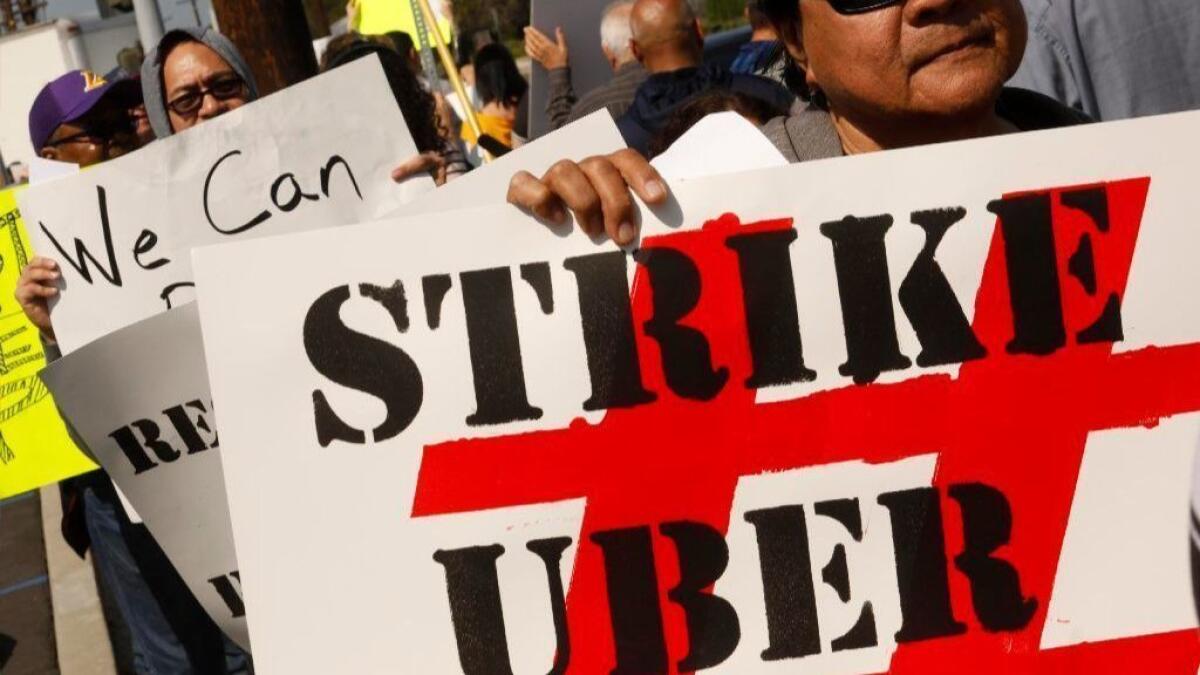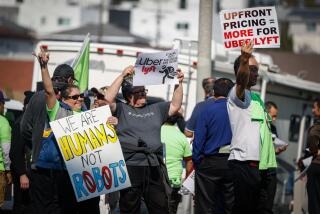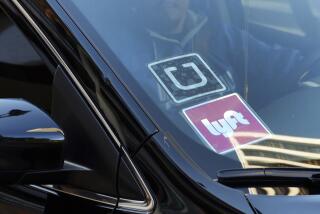Los Angeles Uber drivers join cities across the U.S. in strike ahead of much-anticipated IPO

It was a protest that dealt Uber its biggest blow. When taxi drivers in New York City rallied against President Trump’s travel ban in 2017, Uber became a scapegoat for continuing to operate — leading hundreds of thousands of riders to delete the app as a result.
On Wednesday, just days before Uber is expected to begin trading in one of the tech world’s most anticipated initial public offerings, the company must again contend with a protest.
This time, Uber drivers in 10 U.S. cities, including Los Angeles, Chicago, New York, San Francisco and Washington, as well as some European locations like London, staged strikes Wednesday over what they describe as unfair pay and a lack of transparency. Drivers in Los Angeles are participating in a 24-hour strike and picket line at Los Angeles International Airport.
But the demonstrations did not seem to cause much disruption, and many riders were still able to hail a car with ease. Unlike the viral social media outrage surrounding the #deleteUber campaign two years ago, the biggest risk to Uber isn’t that customers take notice.
It’s that legislators take heed.
While previous demonstrations against ride-hailing companies aimed to alter company policy or change customer perception, organizers say their goal is to persuade legislators to look into mandatory minimum wages, caps on companies’ commissions, and clarity for riders and drivers on costs and pay.
“Gig workers have no sort of protections that labor rights activists fought years for,” said Rebecca Stack Martinez, an Uber and Lyft driver who is helping to organize a strike in San Francisco. “The eight-hour workday, vacation pay … sick time, those kinds of things. I think it’s going to be left up to legislators to step in and actually say, ‘No, you have to treat your workers fairly regardless of how you classify them.’”
Uber’s past is still haunting its business »
Pressuring legislators is a strategic play. In SEC filings, both Uber and Lyft recognize that any regulatory threat to the independent contractor model the companies have relied on to grow quickly and affordably would handicap their still-unprofitable businesses and hamper their ability to show growth to investors.
The companies have already suffered blows to the model in crucial markets. Legislators in New York City have instated minimum wage requirements for Uber and Lyft drivers — a decision that Lyft tried and failed to overturn and that has led both companies to stop hiring new drivers in the city. California legislators are in the midst of attempting to codify a state Supreme Court decision that makes it harder to classify workers as independent contractors. The ruling has largely left tech companies unscathed, however.
On the day of Lyft’s initial public offering in March, Los Angeles drivers met with representatives from Gov. Gavin Newsom’s office. Also in March, Martinez and a group of San Francisco drivers visited legislators in Sacramento to talk about how Uber and Lyft classify them as independent contractors to avoid covering benefits and providing steady wages.
“It was very clear that they had spent hours in front of Uber and Lyft, lobbyists, but had had no idea what it was like from the driver’s perspective,” she said. “On May 8, legislators are going to be listening, you know, and they’re going to realize that it has now gotten to the point that they do need to do something about it.”
The impending protests have garnered support from the likes of presidential candidate Sen. Bernie Sanders (I-Vt.) as well as international driver groups.
“Uber says it can’t pay its drivers more money, but rewarded its CEO with nearly $50 million last year,” Sanders tweeted. “People who work for multibillion-dollar companies should not have to work 70 or 80 hours a week to get by. I stand with the Uber and Lyft drivers going on strike on May 8.”
According to Uber, the company has paid out $78.2 billion in earnings to drivers since 2015 and $1.2 billion in tips. The company had 3.9 million drivers on its platform for the quarter that ended in December 2018.
The company said in a statement to the Los Angeles Times that drivers are “at the heart” of its service and it is committed to making the experience better for them.
“Whether it’s more consistent earnings, stronger insurance protections or fully funded four-year degrees for drivers or their families, we’ll continue working to improve the experience for and with drivers,” an Uber spokesperson said in a statement.
‘I’m really struggling’: Facing pay cuts, some ride-hailing drivers prepare to strike »
Facing high rates of driver turnover, Uber and Lyft have made attempts to appease and retain drivers by introducing features that increase transparency around pay as well as one-time bonuses for longtime drivers as part of the companies’ public offerings.
It hasn’t stopped unsatisfied drivers from organizing. Given the fragmented nature of the workforce, however, amassing driver support has proved difficult. Local driver groups often rely on social media and proprietary apps to raise awareness about protests, but there are few means to ensure drivers actually stay off the app.
“By nature we’re isolated in what we do,” Martinez said. “There’s no directory of who drives in San Francisco. And so you have to spend a lot of money and energy just trying to find drivers alone. And while we do spread the word to the general public or the riders, our focus has been on drivers, which we believe would make more of [an] impact than just consumers showing up alone.”
Although Martinez said the group in San Francisco isn’t relying on riders to take a stand, consumers play a major role. In SEC filings, Uber said it lost hundreds of thousands of customers during the #deleteUber campaign.
But engineering a campaign akin to #deleteUber may not be possible because riders are notoriously difficult to mobilize, especially in places where public transit or taxis are not reliable. Some regular users of the platforms said they expect to find alternative options to travel on Wednesday while others told the Los Angeles Times that the convenience of the service is hard to pass up.
Santa Monica resident Elizabeth Kapocius who said she’s been relying on Lyft to get around while her car is in the shop has already rented a car for Wednesday to avoid crossing the picket line.
“Uber and Lyft simply cannot exist without their drivers and it’s about time the drivers started being treated accordingly,” she said.
Heather Haywood, an Arkansas resident, said she respects drivers’ right to protest but plans to use an Uber or Lyft for her trip to the airport Wednesday.
“Uber is a convenience for travel,” Haywood said.
Twitter: @jmbooyah







